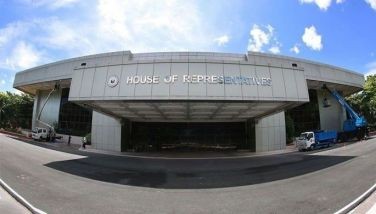Biotechnology can trigger a ‘blue revolution’ – scientist
September 15, 2002 | 12:00am
Biotechnology can trigger a new revolution – a "blue revolution".
"Blue revolution" pertains to great strides in production of food of fish origin.
This is specifically true for fishfarming or aquaculture, which has in recent years been regarded by research and development (R&D) administrators and scientists as the "last frontier" for sustaining contribution of fish to food security.
Biotechnology has the potential to enhance aquaculture productivity, asserted Dr. Felix Ayson, scientist of the government-hosted Southeast Asian Fisheries Development Center Aquaculture Department (SEAFDEC AQD) based in Tigbauan, Iloilo.
To do this, he said, "there is a need to develop a trained critical mass of manpower, and the National Government will have to provide support for this undertaking," Ayson stressed in his discourse for the 11th Dean D.K. Villaluz Memorial Lecture sponsored every year by SEAFDEC AQD.
Over the past few decades, biotechnology has fueled the "Green Revolution," which was brought about by the significant breakthroughs in research in, and eventually production of cereals, notably wheat and rice.
Through this scientific process, high-yielding and pest-resistant food crops have also been subsequently developed.
The same technology can actually be used to fuel another revolution, in another front – a blue revolution.
The lecture is in honor of the late Dean Domiciano K. Villaluz, AQD’s first chief (1973-79), for his significant contribution to the development of the aquaculture industry in the Philippines and in Southeast Asia.
Records show that aquaculture has been growing at an extraordinary rate of 8.8 percent per year since 1986, compared to only 0.7 percent for capture fisheries production. It is also projected to contribute a dramatic increase from 4.53 metric tons in 1998 to 15.5 mt in 2050.
AQD, currently headed by Dr. Rolando R. Platon, is one of the four technical departments of SEAFDEC, a treaty organization founded in 1967 to promote fisheries development in Southeast Asia.
In his lecture titled "Facing the challenges in aquaculture through biotechnology," Dr. Ayson averred that aquaculture’s success depends on the following: complete control of reproduction and life cycle of fish species, genetic background of parent fish stock, efficient and effective detection and prevention of diseases, sufficient supply of good quality water, and innovative management techniques.
"By improving some of these factors, the industry has already made impressive progress over the past 10 years. Application of biotechnology, however, can further speed up the expansion," stated Ayson, as quoted in a SEAFDEC AQD report prepared by Augusto Surtida.
He further cited the breakthroughs in aquaculture biotechnology, including the characterization of complementary DNAs (deoxyribonucleic acid) and genomic sequences of growth hormone (GH) and other growth factors for several fish species in recent years.
As a result, active recombinant GH preparations have become available and its application resulted in significant growth enhancement in fish; the production of transgenic (transferred gene) carp, salmon, and rainbow trout that contain either GM gene promoter sequences or additional copies of the GH gene itself.
"Such fish showed remarkable increase in growth rates, compared to un-manipulated fish, resulting in increased production per unit time and shortened production cycle," Ayson emphasized.
He also noted that outbreaks of diseases during aquaculture operations substantially reduce profitability.
Antiobiotics are often used to arrest such outbreaks. However, prolonged use of antibiotics runs the risk of bacteria developing resistance and of residues in the cultured product.
"The best approach to prevent diseases would be to select natural disease resistance in the species being cultured," he suggested.
For disease prevention, selection for specific pathogen-free (SPF) and specific pathogen-resistant (SPR) strains are complementary approaches that are being addressed in current selective breeding programs in shrimps.
Rapid disease diagnosis and screening for pathogens is one area where molecular biology tools can be applied.
In shrimp culture, Ayson reported, kits have been developed for detection of viral, fungal and bacterial pathogens before clinical symptoms of infection become apparent.
Other innovations in health management are the proliferation of commercial immuno-stimulants and non-specific immune enhancers. These are added to the diet to provide added protection to the fish.
The use of probiotics and microbial food additives is also widespread. Probiotics are living bacterial preparations that improve the balance of the intestinal microflora so that digestive functions are enhanced or pathogenic microbes are inhibited or both.
Probiotics in aquaculture can be used in a number of ways such as enrichment of larval food, inclusion in the diet or addition to the water, which is more as a remediation agent.
Bioremediation, which involves the degradation of hazardous waste to environmentally safe levels by the use of selected microorganisms, bivalves, algae, etc., has been used to reduce organic loading and excess nutrients in shrimp ponds.
Dr. Ayson also said that genetic modification may alter attributes of the organism or create new attributes that affect its interaction with the environment.
The perceived threat of the release of these genetically modified organisms (GMO), whether accidentally or otherwise, is the effect on the environment on the release site, in particular, and on genetic biodiversity, in general.
To reduce such risk, the commonly adapted measure is through sterilization, the SEAFDEC AQD, scientist said.
"Blue revolution" pertains to great strides in production of food of fish origin.
This is specifically true for fishfarming or aquaculture, which has in recent years been regarded by research and development (R&D) administrators and scientists as the "last frontier" for sustaining contribution of fish to food security.
Biotechnology has the potential to enhance aquaculture productivity, asserted Dr. Felix Ayson, scientist of the government-hosted Southeast Asian Fisheries Development Center Aquaculture Department (SEAFDEC AQD) based in Tigbauan, Iloilo.
To do this, he said, "there is a need to develop a trained critical mass of manpower, and the National Government will have to provide support for this undertaking," Ayson stressed in his discourse for the 11th Dean D.K. Villaluz Memorial Lecture sponsored every year by SEAFDEC AQD.
Over the past few decades, biotechnology has fueled the "Green Revolution," which was brought about by the significant breakthroughs in research in, and eventually production of cereals, notably wheat and rice.
Through this scientific process, high-yielding and pest-resistant food crops have also been subsequently developed.
The same technology can actually be used to fuel another revolution, in another front – a blue revolution.
The lecture is in honor of the late Dean Domiciano K. Villaluz, AQD’s first chief (1973-79), for his significant contribution to the development of the aquaculture industry in the Philippines and in Southeast Asia.
Records show that aquaculture has been growing at an extraordinary rate of 8.8 percent per year since 1986, compared to only 0.7 percent for capture fisheries production. It is also projected to contribute a dramatic increase from 4.53 metric tons in 1998 to 15.5 mt in 2050.
AQD, currently headed by Dr. Rolando R. Platon, is one of the four technical departments of SEAFDEC, a treaty organization founded in 1967 to promote fisheries development in Southeast Asia.
In his lecture titled "Facing the challenges in aquaculture through biotechnology," Dr. Ayson averred that aquaculture’s success depends on the following: complete control of reproduction and life cycle of fish species, genetic background of parent fish stock, efficient and effective detection and prevention of diseases, sufficient supply of good quality water, and innovative management techniques.
"By improving some of these factors, the industry has already made impressive progress over the past 10 years. Application of biotechnology, however, can further speed up the expansion," stated Ayson, as quoted in a SEAFDEC AQD report prepared by Augusto Surtida.
He further cited the breakthroughs in aquaculture biotechnology, including the characterization of complementary DNAs (deoxyribonucleic acid) and genomic sequences of growth hormone (GH) and other growth factors for several fish species in recent years.
As a result, active recombinant GH preparations have become available and its application resulted in significant growth enhancement in fish; the production of transgenic (transferred gene) carp, salmon, and rainbow trout that contain either GM gene promoter sequences or additional copies of the GH gene itself.
"Such fish showed remarkable increase in growth rates, compared to un-manipulated fish, resulting in increased production per unit time and shortened production cycle," Ayson emphasized.
He also noted that outbreaks of diseases during aquaculture operations substantially reduce profitability.
Antiobiotics are often used to arrest such outbreaks. However, prolonged use of antibiotics runs the risk of bacteria developing resistance and of residues in the cultured product.
"The best approach to prevent diseases would be to select natural disease resistance in the species being cultured," he suggested.
For disease prevention, selection for specific pathogen-free (SPF) and specific pathogen-resistant (SPR) strains are complementary approaches that are being addressed in current selective breeding programs in shrimps.
Rapid disease diagnosis and screening for pathogens is one area where molecular biology tools can be applied.
In shrimp culture, Ayson reported, kits have been developed for detection of viral, fungal and bacterial pathogens before clinical symptoms of infection become apparent.
Other innovations in health management are the proliferation of commercial immuno-stimulants and non-specific immune enhancers. These are added to the diet to provide added protection to the fish.
The use of probiotics and microbial food additives is also widespread. Probiotics are living bacterial preparations that improve the balance of the intestinal microflora so that digestive functions are enhanced or pathogenic microbes are inhibited or both.
Probiotics in aquaculture can be used in a number of ways such as enrichment of larval food, inclusion in the diet or addition to the water, which is more as a remediation agent.
Bioremediation, which involves the degradation of hazardous waste to environmentally safe levels by the use of selected microorganisms, bivalves, algae, etc., has been used to reduce organic loading and excess nutrients in shrimp ponds.
Dr. Ayson also said that genetic modification may alter attributes of the organism or create new attributes that affect its interaction with the environment.
The perceived threat of the release of these genetically modified organisms (GMO), whether accidentally or otherwise, is the effect on the environment on the release site, in particular, and on genetic biodiversity, in general.
To reduce such risk, the commonly adapted measure is through sterilization, the SEAFDEC AQD, scientist said.
BrandSpace Articles
<
>
- Latest
Latest
Latest
May 14, 2024 - 3:43pm
By Ian Laqui | May 14, 2024 - 3:43pm
April 10, 2024 - 5:12pm
By Ian Laqui | April 10, 2024 - 5:12pm
March 4, 2024 - 3:32pm
By Ian Laqui | March 4, 2024 - 3:32pm
March 4, 2024 - 2:12pm
By Kristine Daguno-Bersamina | March 4, 2024 - 2:12pm
February 17, 2024 - 2:31pm
February 17, 2024 - 2:31pm
Recommended




























